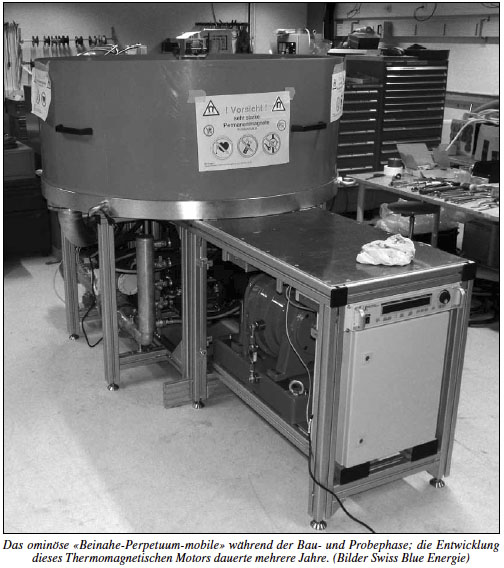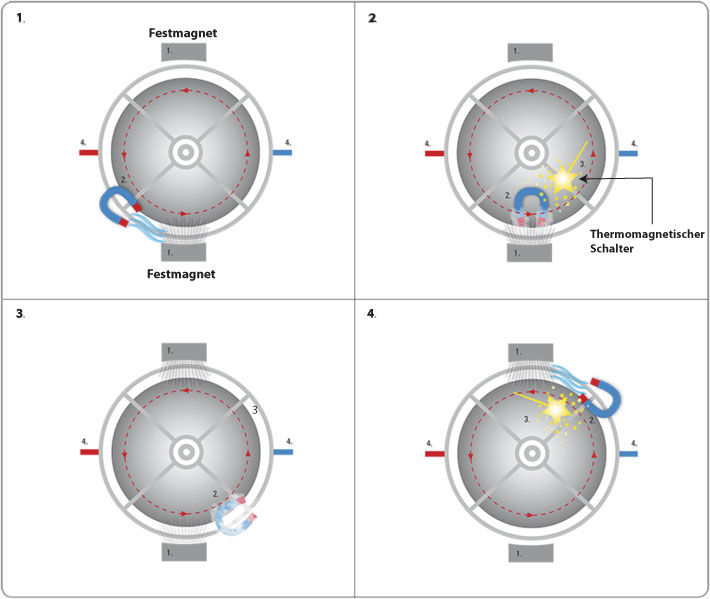Harnessing untapped energy
Harnessing untapped energy
Blue Energy – a revolutionary innovation
by Heini Hofmann
The inventors Thomas Edison and Nikola Tesla, known to every student of physics, wouldn’t have imagined in their wildest dreams that around 125 years later, thanks to an ophthalmologist, their vision of a thermo-magnetic drive system would be put into revolutionary practice – a welcome contribution to the energy turnaround.
The idea to use low-temperature energy below 100 °C, one of the largest sources of energy worldwide, for generating electricity is old. In 1888 Thomas Edison described a pyro-magnetic generator and Nikola Tesla described the magneto-caloric motor one year later. Since then, there were still dozens of attempts to build a Thermo-Magnetic Motor (TMM).
Also in Switzerland Professor Peter Egolf and his team from the Western Switzerland University of Applied Sciences have repeatedly described the feasibility and applicability of TMM engines, supported by the Swiss Federal Office of Energy. But no one succeeded to build a viable system providing continuous power – until an ophthalmologist and a passionate inventor now had a visionary inspiration. It proves that innovations are not always coming from established think tanks, but occasionally from smart individual brains.

Industrial prototype planned
Since a demonstrator has been put into operation in the Thermal Bath of Zurzach some time ago, and a first industrially applicable prototype is planned to be tested in Switzerland this year, movement comes into this story. As in the past little boys with shiny-eyes watched the flywheel of the toy steam engine come into motion, so the blue energy team in Zurzach became feverish when their TMM-baby began to work – since there is a big potential in it, as science confirms.
Still worldwide there are only a few technologies capable of using low-temperature energy economically. The Organic Ranking Cycle (ORC) is one of those, it is a mature process, however in contrast to TMM plants it is complex, maintenance-intensive and the cost of this electricity is uninterestingly high. Research is going on also on thermoelectric generators that convert two heat sources of uneven temperature directly into energy. But here one focuses on high temperatures, for example engine exhaust gases.
However, in the low temperature range there is still an area to work through without much competition, making for a technology and market leadership for the Swiss Blue Energy Ltd headquartered in Zurzach, which works closely with the Swiss Federal Office of Energy. The three leading figures of this new technology with great potential for application in industrial and developing countries are ophthalmologist Nikolaus Vida from Bad Zurzach as main promotor, Professor Hugo Tschirky of the ETH Zurich and Professor Kurt Heiniger of the Northwestern Switzerland University of Applied Sciences and Arts FHNW in Windisch. (Tragically Professor Heiniger was fatally injured in an accident in his beloved mountains after this article was issued; the project will however be continued.)

The magnetocaloric-driving principle:
1. ferromagnetic material is beeing attracted by the stationary magnet,
2. “thermo-magnetic switch” de-magnetises the material,
3. de-magnetised material escapes from the magnetic field,
4. thermo-magnetic switch re-activates the ferro-magnetic effect, material is again attracted.
(pictures Swiss Blue Energy)
Thermomagnetic carousel
How does this “miracle machine” work? Everyone knows that a magnet sticks to iron. It is less known that it falls off by itself again when the iron is heated above the Curie Point. This is because the building elements (atoms, molecules, ions) are uniformly aligned in the cold iron and therefore respond to an external magnetic field. But the building elements turn into an oscillatory instability when warming and lose their structured arrangement once they reach the Curie temperature. They don’t respond to a magnet any longer. This process is cyclic.
But the construction of a powerful Thermo-Magnetic Motor requires controlling the changes in the state of appropriate magneto-caloric materials under the influence of temperature in very short time, in milliseconds. Key to this are suitable ferromagnetic materials and a thermomagnetic switch which is activated by a medium of different temperature. To realize this was the hard nut to be cracked in order to be successful.
In a cylindrical (and, as it befits Blue Energy, blue-colored) housing is a rotating plate, similar to a mill wheel. The magneto-caloric material is arranged on it as a ring and passes along several permanent magnets. In front of these it is put into a magnetically active state, it is attracted and puts the plate into rotational movement. To maintain it, the material is demagnetized by means of a thermal switch when passing the magnets. This process (Curie effect) is repeatedly running, so that, like driven by an invisible hand, the high-tech carousel rotates.
The substitution of gadolinium – a hard nut to crack
That is the reason why a lay person may be tempted to believe in a perpetuum mobile. But there is also an impulse behind this. The “fuel” for the rotary movement is – what a wonder – available warm and cold water in the low temperature range. Yet unlike a mill water wheel, this “water wheel” does not use hydro energy but instead the difference in temperature. That is why there are feeders for hot and cold water leading into the cylinder body with the horizontal plate, and the used water flows off.
At the present state of the art hot water of somewhat over 30° C with a difference of 20° C to the cold water is already sufficient. So the waste water of the thermal bath in Zurzach has been used successfully for the demonstration prototype. In the case of very warm waste water it would even be possible to use it several times in a cascade system, whereby the power output would still increase.
But the technical crux lies with the linchpin of this innovative machine, the magnetocaloric material, which causes the magnetization effect. Currently from the group of rare earth elements only Gadolinium (with a Curie temperature of about 19° C) can be used in the low temperature range. But it is expensive and difficult to process. Therefore, scientists in cooperation with Swiss Blue Energy are conducting research for alternative materials that make it possible to choose the optimal Curie temperatures compatible with the nature of the locally available water sources.
An active contribution to the energy turnaround
If this succeeds, the potential uses are almost unlimited. Possible heat sources industrial effluents with different temperature levels as well as solar and geothermal energy from natural sources. The use of industrial waste heat is also an important contribution to avoiding CO2 emissions. Blue-energy plants can be operated between warmed water (by solar thermal or PV-cooling system) and colder water sharing the temperature of its surroundings. Ideal are sunny locations on lakes, rivers and the ocean.
Regarding geothermal energy, which is present everywhere: Since only cold water and hot water under the temperature of 100° C are required, no expensive and problematic deep drilling is necessary. Cost-effective drilling in subsurface layers is sufficient. Tectonically active regions such as Iceland or Japan are just about optimal locations for Swiss Blue-energy plants. Studies also show that efficiency in the low temperature range is considerably better than that of all other technologies available today.
This novel, thermo-magnetic method for commercial and industrial use will render it possible to make use of the unlimited quantities of waste heat and natural heat in the low temperatures to produce rotational energy, which can for example serve to drive electric generators. Blue energy thus seems predestined to make a major contribution to shaping the desired energy turnaround in Switzerland as well as internationally. •
Additional Information:
<link http: www.swiss-blue-energy.ch>www.swiss-blue-energy.ch
(Translation Current Concerns)
Eureka-Project already approved
In the further development of Swiss Blue Energy to market maturity there are still some hurdles to overcome, first the optimization of the magnetocaloric material and thus the „thermomagnetic switch“, but also the configuration of useful plant dimensions for industrial use. But everything seems to be well under way. Large bright spot here: An Eureka project for the exploration of new magnetocaloric materials in collaboration with the Technical University of Delft has already been approved.
The advantages of this innovation are evident, and the application potential of this new technology is practically unlimited. The Blue-Energy-modules can be constructed in various orders of magnitude, are emission-free, noise-reduced and practically without interventions in landscapes. They are based on simple, low-wear mechanics, are low in production costs and easily transportable for decentralized use (in remote locations or as well in developing countries). They can also be started up within seconds and turned off so that there is no need for an operating storage system.
Such flexible operation and the simplicity of the system make it possible to generate electricity, which is relatively low priced compared to other technologies. Briefly: The Blue-Energy-Principle corresponds to the growing environmental awareness to use surplus heat sensibly rather than disposing of it in rivers or evaporating it in cooling towers. This new star in the electricity-sky should therefore contribute to brighten the future of energy.